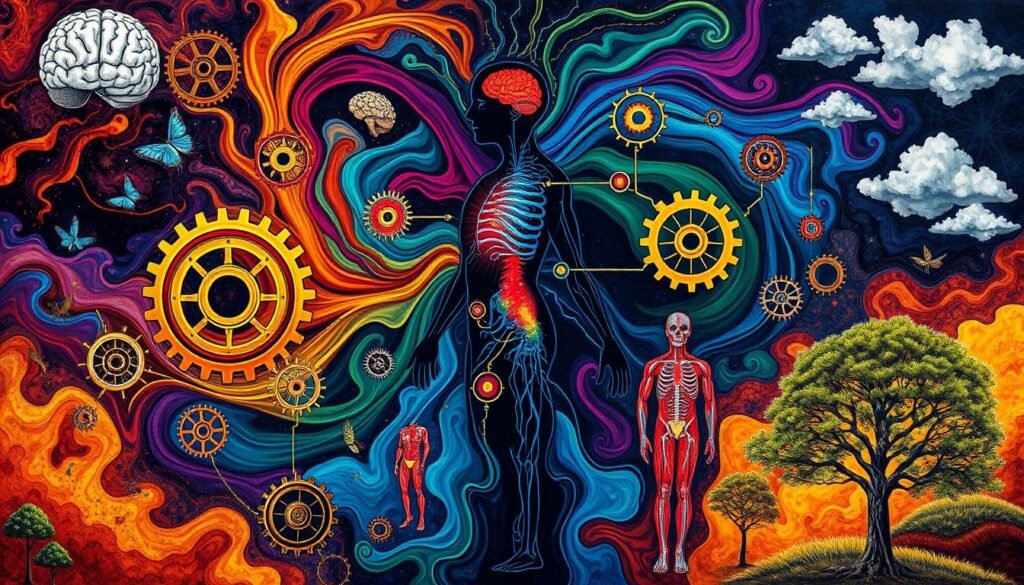Chronic pain affects over 100 million adults in the United States. It’s more common than diabetes, heart disease, and cancer combined. Pain is complex, involving biology, psychology, and emotions. This makes treating it a big challenge.
Psychological therapies are key in managing chronic pain. They help tackle the physical, emotional, and psychological sides of pain. This can make a big difference in how people feel and live with chronic pain.
Key Takeaways
- Chronic pain is a widespread issue, affecting over 100 million adults in the United States.
- Pain has biological, psychological, and emotional components, necessitating a comprehensive treatment approach.
- Psychological interventions are essential in addressing the multifaceted nature of chronic pain.
- Psychological therapies can potentially reduce pain intensity and improve overall quality of life for those suffering from chronic pain.
- Understanding the role of psychology in pain management is crucial for developing effective treatment strategies.
Understanding Chronic Pain and Its Psychological Impact
Chronic pain is more than just physical pain. It affects a person’s emotional, social, and mental health. The Institute of Medicine says over 100 million adults in the U.S. live with chronic pain. This is more than those with diabetes, heart disease, and cancer combined.
The Biopsychosocial Nature of Pain
The biopsychosocial model helps us understand chronic pain. It shows that pain comes from biological, psychological, and social factors. This model highlights how our thoughts, feelings, and actions play a big role in our pain experience.
Emotional and Physical Effects of Chronic Pain
People with chronic pain are at higher risk for mental health issues. This includes depression, anxiety, and PTSD. Studies show that psychological treatments for chronic pain can work as well as surgery in managing pain.
Impact on Quality of Life
Chronic pain can really hurt a person’s quality of life. It can make physical function worse, increase disability, and raise the risk of obesity and sleep problems. It’s important to manage stress and pain-related distress to avoid health issues like high blood pressure and heart disease.
Using a biopsychosocial approach to manage chronic pain is key. It looks at the physical, mental, and social aspects of pain. This approach is vital for improving the well-being and quality of life for those with chronic pain.

“Psychological treatments for chronic pain can be as effective as surgery for relieving chronic pain, altering how the brain processes pain sensations.”
The Role of Psychology in Pain Management
Psychologists are key in helping people deal with chronic pain. They work with patients and families in private practice or as part of healthcare teams. They focus on pain catastrophizing, fear of pain, and pain acceptance to help manage pain.
Pain catastrophizing can lead to depression, anxiety, and trouble with daily activities. People who worry a lot about their pain tend to feel more pain and react more strongly. Pain-related fear also makes pain worse and limits what people can do.
But, pain acceptance can help people feel better. Those who accept their pain without trying to get rid of it often live better lives. They function better in work and social situations.
Therapies like Cognitive-Behavioral Therapy (CBT), Acceptance and Commitment Therapy (ACT), and Mindfulness-Based Interventions work well. They help manage pain by changing how people think and feel about it.

“Pain is the most common reason for patients to enter health-care settings and for self-medication.”
Psychologists help patients find better ways to cope with pain. This improves their mood and quality of life. It leads to better management of chronic pain in the long run.
Cognitive Behavioral Therapy (CBT) for Pain Management
Cognitive Behavioral Therapy (CBT) is a top choice for managing chronic pain. It uses a model that looks at physical, psychological, and social factors. CBT helps patients change how they think and act to better handle pain.
Core Components of CBT for Pain
The main parts of CBT for chronic pain are:
- Psychoeducation: Teaching patients about pain’s causes and how thoughts and actions affect it.
- Relaxation strategies: Showing patients how to use deep breathing, muscle relaxation, and imagery to reduce stress and pain.
- Behavioral pacing: Helping patients slowly increase their activities to avoid pain spikes.
- Behavioral activation: Encouraging patients to do things they enjoy to boost mood and function.
- Cognitive restructuring: Helping patients change negative thoughts about pain to more positive ones.
Evidence-Based Benefits
Studies show that cognitive behavioral therapy can slightly reduce pain and distress in chronic pain patients. These benefits last for 6-12 months when compared to usual care.
Treatment Duration and Outcomes
CBT for chronic pain usually involves weekly sessions lasting 45 minutes to two hours. Patients attend 8 to 24 sessions. It improves quality of life and daily activities, making it a key part of pain management techniques.

Psychological Therapies for Chronic Pain Management
Psychological interventions are key in managing chronic pain. They help improve physical, emotional, social, and work life, not just pain. Chronic pain is complex and needs a team effort, combining psychology and medicine.
There are four main types of psychological therapies for chronic pain: operant-behavioral therapy, cognitive-behavioral therapy, mindfulness-based therapy, and acceptance and commitment therapy. Each targets different parts of pain and distress.
Operant-Behavioral Therapy
Operant-behavioral therapy looks at how the environment affects pain behaviors. It aims to change bad pain behaviors, like too much rest, to better ones. This is done through positive rewards and slowly getting used to new things.
Cognitive-Behavioral Therapy (CBT)
Cognitive-Behavioral Therapy (CBT) is well-studied and proven to help with chronic pain. It helps change negative thoughts and behaviors that make pain worse. People learn to cope with pain better and live a better life.
Mindfulness-Based Interventions
Mindfulness-based therapies, like Mindfulness-Based Stress Reduction (MBSR) and Mindfulness-Based Cognitive Therapy (MBCT), are getting more attention. They teach being present and accepting pain, helping people handle pain better.
Acceptance and Commitment Therapy (ACT)
Acceptance and Commitment Therapy (ACT) focuses on being flexible and living by values. It teaches people to accept pain and do things that matter to them.
Using these therapies together can help people with chronic pain a lot. Healthcare teams can offer better support by combining psychology and medicine. This can really help people with chronic pain feel better and live better lives.
| Psychological Therapy | Key Focuses | Potential Benefits |
|---|---|---|
| Operant-Behavioral Therapy |
|
|
| Cognitive-Behavioral Therapy (CBT) |
|
|
| Mindfulness-Based Interventions |
|
|
| Acceptance and Commitment Therapy (ACT) |
|
|

One in five adults worldwide has moderate to severe chronic pain, rising to one in three over 65. Psychological therapies are key in managing this global issue. They offer effective strategies and improve the lives of those with chronic pain.
“Chronic pain is a complex and multifaceted condition that requires a multidisciplinary approach, integrating psychological strategies alongside medical treatments.” – Beth Darnall, PhD, Clinical Professor at Stanford University
Acceptance and Commitment Therapy (ACT) Approaches
Acceptance and Commitment Therapy (ACT) is a proven method for dealing with chronic pain. It focuses on accepting pain and thoughts without trying to control them. This approach helps people live their lives fully, even with pain.
Psychological Flexibility Model
At the heart of ACT is the psychological flexibility model. It teaches patients to accept their pain and feelings. This way, they can live a life that matters to them, even with chronic pain.
Pain Acceptance Strategies
Pain acceptance is key in ACT. It’s about accepting pain without judgment and living a meaningful life. Patients learn to be more flexible with their pain, allowing them to do things they value.
Value-Based Living with Pain
ACT also focuses on living based on personal values. Patients find their values and act on them, even with pain. This approach helps them find purpose and live better lives.
“Acceptance and commitment therapy (ACT) for chronic pain aims to increase patients’ activity and function, leading to positive outcomes such as an increase in physical and social activity and a decrease in pain-related medical visits.”
Studies show ACT is effective for chronic pain. It improves flexibility, acceptance, and function. By focusing on values, patients can manage pain and live fulfilling lives.
Mindfulness-Based Interventions
Chronic pain is a big problem, affecting over 56% of U.S. adults in the last 3 months. Daily pain is experienced by 11% of the population. Mindfulness-based interventions (MBIs) are seen as a hopeful solution.
MBIs teach people to accept pain without judgment. They use meditations and daily practice to help manage pain. The goal is to learn how to cope with pain better.
Research shows MBIs can help with chronic pain. A review found 20 studies on Brief Mindfulness-Based Interventions (BMBIs). These interventions show promise in managing pain, especially if they last more than 5 minutes.
A study with 90 patients showed MBPM (Mindfulness-Based Pain Management) improved pain management. It also helped with acceptance and quality of life. Non-fibromyalgia patients saw bigger benefits than those with fibromyalgia.
The opioid crisis is a major issue in the U.S., with over 90 overdose deaths daily. Mindfulness-based interventions are a non-addictive way to manage chronic pain. They help people improve their quality of life and manage pain better.
Behavioral Therapy and Pain Management Skills
Behavioral therapy is key in managing chronic pain. It helps change how we react to pain. This includes using operant-behavioral therapy to change our actions through rewards and punishments.
Operant-Behavioral Approaches
Operant-behavioral therapy is very effective for chronic pain. It changes how we behave and react to pain. This therapy rewards good behaviors and stops bad ones.
Activity Pacing Techniques
Activity pacing is also important in pain therapy. It helps balance activities and rest to avoid pain. This way, people with chronic pain can do more without making pain worse.
Behavioral Modification Strategies
Changing specific behaviors is crucial in pain management. This includes stopping actions that make pain worse. With a therapist’s help, people can learn better ways to cope with pain.
Behavioral therapy and pain management skills are vital for treating chronic pain. They help manage both physical and mental aspects of pain. This way, patients can better control their pain and improve their lives.
| Therapy | Evidence-Based Benefits | Limitations |
|---|---|---|
| Cognitive Behavioral Therapy (CBT) | – Small to very small benefits for pain, disability, and distress – Effects largely maintained at follow-up compared to usual care |
– Moderate to very low quality of evidence – Insufficient data on adverse events |
| Behavioral Therapy (BT) | – No significant difference compared to active control or usual care | – Limited number of studies analyzed – Moderate to very low quality of evidence |
| Acceptance and Commitment Therapy (ACT) | – No significant difference compared to active control for pain, disability, and distress – Two studies showed large benefit for reducing disability |
– Limited number of studies analyzed – Moderate to very low quality of evidence |
The quality of evidence for these therapies varies. But, it shows that behavioral therapy for pain is helpful. It includes operant-behavioral therapy and teaching pain coping skills.
Integrating Psychological and Medical Treatments
Managing chronic pain well often needs a team effort. This team includes both psychological and medical experts. They work together to treat the whole person, not just the pain.
Psychologists team up with doctors, physical therapists, and others. Together, they create plans that mix talking therapies with medicine and physical exercises. This way, they tackle pain from all angles.
The U.S. Department of Health and Human Services backs this team approach. They say it’s key to treat pain in a way that focuses on the patient. This method looks at the physical, emotional, and social sides of health.
When psychological and medical treatments are combined, patients often do better. This mix of therapies and treatments can handle the many effects of chronic pain. A team effort means each patient gets a plan that fits their needs best. This helps improve their life and well-being.



